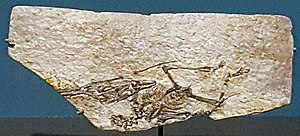Nemicolopterus
| Nemicolopterus | ||||||||
|---|---|---|---|---|---|---|---|---|

Cast of the holotype |
||||||||
| Temporal occurrence | ||||||||
| chalk | ||||||||
| 120 million years | ||||||||
| Locations | ||||||||
| Systematics | ||||||||
|
||||||||
| Scientific name | ||||||||
| Nemicolopterus | ||||||||
| Wang , Kellner , Zhou & Campos , 2008 | ||||||||
Nemicolopterus is a genus of short-tailed pterosaurs described in 2008, with N. crypticus as the only species. The genus name Nemicolopterus comes from the following Greek words: "Nemos" means "forest", "Ikolos" means "inhabitant" and Latinized means "pteron" "Wing". The specific epithet crypticus comes from "kryptos" and means "hidden". "Nemicolopterus crypticus" means "hidden, flying forest dweller". He lived in the Jehol group in China120 million years ago.
N. crypticus is known from a single fossil in the collection of the Institute of Vertebrate Paleontology and Paleoanthropology of the Chinese Academy of Sciences in Beijing , China . The fossil was found in the Jiufotang Formation , the age of which is in the Aptian (120 million years). It was in the village Luzhhouou the city Yaolugou , county Jianchang , City Huludao , western province of Liaoning in northeast China's discovered.
features
The wingspan of a little less than 25 centimeters makes N. crypticus smaller than all other known pterosaur fossils, with the exception of a few newly hatched specimens. The only known specimen is not fully grown, but Wang and colleagues cite the amount of bone fusions and ossification of the toes, gastralia, and sternum as an indication that it is a hatchling and not a hatchling. Darren Naish argued, however, that due to the fact that pterosaurs are high-grade nests , bone fusion and ossification could occur very early and that the specimen found could indeed be a hatchling of the genus Sinopterus .
Nemicolopterus is a toothless pterosaurs . Wang and co-workers concluded that it is a primitive intermediate link between the pteranodontoid and the dsungaripteroid . Although Nemicolopterus is tiny, some members of these groups, such as Quetzalcoatlus, eventually evolved into the largest flying animals that ever lived.
The toes and claws of Nemicolopterus show clear adaptations to embracing tree branches. Most pterosaurs are known from marine sediments , which means they likely caught fish in the ocean and landed on the adjacent beaches or cliffs. Nemicolopterus, on the other hand, is one of only a few known pterosaurs that were found in the interior of continents, probably hunted insects and lived in the forest canopy. It should be noted, however, that the contemporary pterosaur line Tapejaridae (like Sinopterus , which might be the same as Nemicolopterus ) also has strong adaptations for climbing.
Individual evidence
- ↑ Wang, X., Kellner, AWA, Zhou, Z., and Campos, DA (2008). Discovery of a rare arboreal forest-dwelling flying reptile (Pterosauria, Pterodactyloidea) from China . Proceedings of the National Academy of Sciences, 106 (6): 1983-1987. doi : 10.1073 / pnas.0707728105
- ↑ Darren Naish, Tiny pterosaurs and pac-man frogs from hell , March 19, 2008
- ↑ artist's depiction
